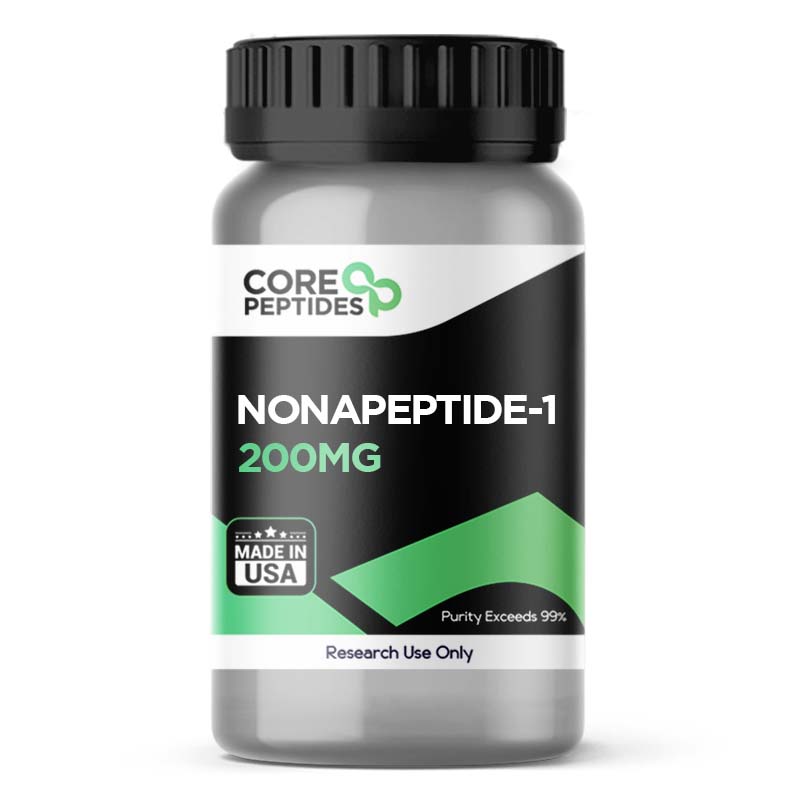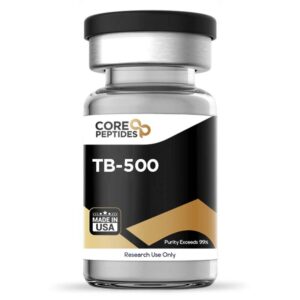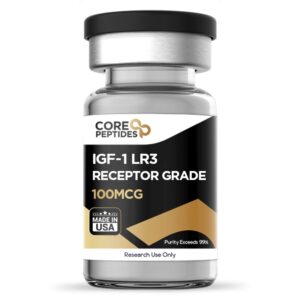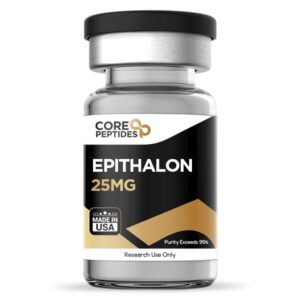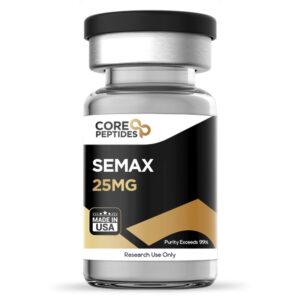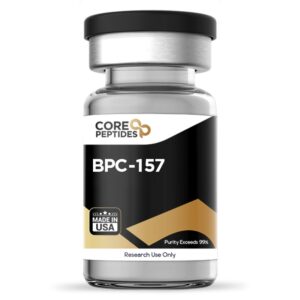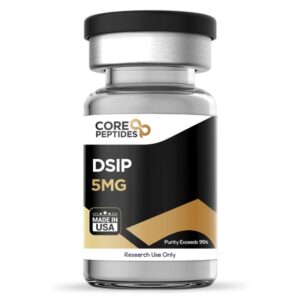Nonapeptide-1 (200mg)
$200.00
Size: 200mg
Contents: Nonapeptide-1
Form: Lyophilized powder
Purity: >99%
SKU: P-NONAPEPTIDE-1
FREE Shipping on $200+ orders
Discount per Quantity
| Quantity | Discount | Price |
|---|---|---|
| 5 - 8 | 5% | $190.00 |
| 9 + | 10% | $180.00 |
Nonapeptide-1
Nonapeptide-1 is a nine amino acid peptide that was first developed in the 1990s, sparking research interest due to its potential to inhibit the synthesis of melanin, the main pigment in mammals responsible for color in the skin, fur, hair, eyes, etc. The research on Nonapeptide-1 is still in its early stages, and much is still unknown about its potential and mechanisms of action.
Studies on Nonapeptide-1 have primarily focused on its potential to inhibit melanin production by interfering with the signaling pathway involved in melanogenesis. Specifically, Nonapeptide-1 is thought by researchers to possibly inhibit the melanocortin-1 receptors, which may prevent the action of melanocyte-stimulating hormones and the activation of the enzyme tyrosinase, which is necessary for the synthesis of melanin.(1) By doing so, Nonapeptide-1 may have a reducing potential on hyperpigmentation and skin tone in animal studies. Nevertheless, further studies are needed to fully understand the potential of this peptide.
Chemical Makeup
Molecular formula: C61H87N15O9S
Molecular weight: 1206.5
Research and Clinical Studies
Nonapeptide-1 Discovery and Mechanism of Action
Scientists have investigated a peptide library of 31,360 structurally different melanocortin-1 receptor antagonists with the aim of finding the most potentially potent inhibitor of these receptors.(2) These melanocortin-1 receptors may be found in melanocytes, which are pigment-producing cells. One of the main agonists of these receptors is considered to be the alpha-melanocyte-stimulating hormone (α-MSH).
α-MSH is a neuropeptide thought to be involved in regulating pigmentation, energy homeostasis, and immune function. The pituitary gland and the skin produce it. α-MSH may stimulate melanin production by binding to the melanocortin-1 receptor on melanocytes and activating a signaling cascade that increases tyrosinase activity and melanin production. Tyrosinase is the rate-limiting enzyme in melanogenesis.(3) In addition, α-MSH may also act as an antagonist for the agouti signaling protein (ASP), which inhibits MC1R activity and reduces melanin production.
The researchers suggested that the most potent antagonist of all 31,360 peptides was Met-Pro-D-Phe-Arg-D-Trp-Phe-Lys-Pro-Val-NH2, aka nonapeptide-1.(2) The scientists reported that it "has an IC50 value of 11 +/- 7 nM'' and the "analysis revealed that D-Trp5 and Phe6 were crucial to its antagonistic properties which could be potentiated by D-Phe3."
Nonapeptide-1 and Skin Pigmentation
The potential action of Nonapeptide-1 has been researched in both clinical and laboratory settings. In one in vitro study, keratinocyte cell line (HaCaT) cells and epidermal melanocytes (HEM) were exposed to UVA and imbued with different concentrations of the acetate salt of Nonapeptide-1.(4)
The scientists accessed cell viability, melanin content, and tyrosinase activity. The scientists suggested that Nonapeptide-1 downregulated melanocortin 1 receptor expression without affecting α-MSH levels, and might significantly decrease the expression of tyrosinase, TRP1 (tyrosinase-related protein-1), TRP2 (tyrosinase-related protein-2), and MITF (microphthalmia-associated transcription factor) with or without concomitant UVA radiation. Besides, the researchers further posited that cells infused with nonapeptide-1 may significantly increase the ability to resist melanin production.
More recent research on nonapeptide-1 also hypothesizes that the peptide may produce an apparent skin lightening by at least 33% and suggested a continued improvement over time.(5) The only clinical trial on the topic was a prospective double-blinded parallel-group randomized controlled pilot study that lasted eight months and had three phases.(6) The researchers reported an apparent improvement in severity scores of melasma and mean melanin index. They also commented, "The melasma area and severity index score showed a consistent reduction in the case group, whereas it increased in the control group from baseline."
Nonapeptide-1 and Future Research Potential
Apart from melanocytes, the melanocortin 1 receptors that Nonapeptide-1 potentially inhibits may be expressed in other cells, such as nerve cells and immune cells. More specifically, the melanocortin 1 receptors may be found in the periaqueductal gray matter, which plays a major role in nociception.(7)
Scientists have conducted experiments on mice with overexpression of an endogenous antagonist of the melanocortin 1 receptor compared to control mice.(8) They tested their response to painful and non-painful stimuli and their response to inflammatory and neuropathic pain. Additionally, they tested their aversion to capsaicin, which may activate the TRPV1 noxious heat receptor, using a paired preference paradigm.
The scientists indicated that mice overexpressing the melanocortin 1 receptor antagonist exhibited an apparently reduced inflammatory pain response and a slower onset of inflammation-induced hypersensitivity and allodynia. They were also observed to exhibit a decreased aversion to moderate concentrations of capsaicin. The scientists highlighted that these results occurred only in female mice and that "mice of either sex did not show any effect of mutant genotype on neuropathic pain."
Studies also suggest that melanocortin 1 receptors may play a role in the growth and survival of melanoma tumor cells.(9) Melanoma is a type of skin cancer with a high mortality rate, and mutations in the melanocortin 1 receptor gene may be associated with changes in the risk of developing melanoma. In this study, the researchers inhibited melanocortin 1 receptors using natural inhibitors, which reduced melanin synthesis and morphological heterogeneity in murine B16-F10 melanoma cells. They found that the inhibition resulted in slower tumor cell growth and a more homogeneous size and morphology of the tumors.
The study suggests that melanocortin 1 receptors may play an important role in regulating melanoma growth and morphology, and persistent inhibition of melanocortin 1 receptors may significantly slow the growth rate of the tumor cells that express these receptors. Nonapeptide-1 hasn't been researched regarding its potential impact on melanoma tumor cells.
Nonapeptide-1 is available for research and laboratory purposes only. Please review and adhere to our Terms and Conditions before ordering.
References:
- Dhatt S (2006) Rebuilding the dermal matrix with this new in-demand ingredient in skin care products. Aesthetic Trends Technol 17–20
- Jayawickreme, C. K., Quillan, J. M., Graminski, G. F., & Lerner, M. R. (1994). Discovery and structure-function analysis of alpha-melanocyte-stimulating hormone antagonists. Journal of Biological Chemistry, 269(47), 29846-29854.
- Gaston, L. S., & Majzoub, J. A. (2022). Adrenocorticotrophin. In The Pituitary (pp. 51-89). Content Repository Only!.
- Chen, J., Li, H., Liang, B., & Zhu, H. (2022). Effects of tea polyphenols on UVA-induced melanogenesis via inhibition of α-MSH-MC1R signalling pathway. Postepy dermatologii i alergologii, 39(2), 327–335. https://doi.org/10.5114/ada.2022.115890
- Mohammed, Y. H., Moghimi, H. R., Yousef, S. A., Chandrasekaran, N. C., Bibi, C. R., Sukumar, S. C., Grice, J. E., Sakran, W., & Roberts, M. S. (2017). Efficacy, Safety and Targets in Transdermal Active and Excipient Delivery. Percutaneous Penetration Enhancers Drug Penetration Into/Through the Skin: Methodology and General Considerations, 369–391. https://doi.org/10.1007/978-3-662-53270-6_23
- Chatterjee, M., Neema, S., & Rajput, G. R. (2021). A randomized controlled pilot study of a proprietary combination versus sunscreen in melasma maintenance. Indian journal of dermatology, venereology and leprology, 88(1), 51–58. https://doi.org/10.25259/IJDVL_976_18
- Xia, Y., Wikberg, J. E., & Chhajlani, V. (1995). Expression of melanocortin 1 receptor in periaqueductal gray matter. Neuroreport, 6(16), 2193-2196.
- Delaney, A., Keighren, M., Fleetwood-Walker, S. M., & Jackson, I. J. (2010). Involvement of the melanocortin-1 receptor in acute pain and pain of inflammatory but not neuropathic origin. PloS one, 5(9), e12498. https://doi.org/10.1371/journal.pone.0012498
- Kansal, R. G., McCravy, M. S., Basham, J. H., Earl, J. A., McMurray, S. L., Starner, C. J., Whitt, M. A., & Albritton, L. M. (2016). Inhibition of melanocortin 1 receptor slows melanoma growth, reduces tumor heterogeneity and increases survival. Oncotarget, 7(18), 26331–26345. https://doi.org/10.18632/oncotarget.8372

